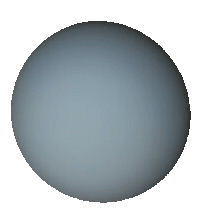Hanging like a giant cue ball in space, Uranus has hidden its secrets in frozen gases. The icy planet Uranus is a smaller version of Jupiter and not the small rocky bodies like Earth. It has faint rings and a number of moons. Uranus takes some 84 years to orbit the Sun. It rotates on its side and so half the time one pole is towards the Sun and then the other making each of the four seasons last about 20 years. The faint bluish color of the planet is because the methane gase in the atmosphere absorbs red light and reflects blue light.
On March 13, 1781, an English astronmer named WIlliam Herschel discovered the planet but thought it might have been a comet. More observations and calculations by Herschel and others confirmed that it was indeed a planet. Since it was the first new planet found, Herschel had the honor of naming it, so, Herschel's plaent became Georgium Sidus (George's Star) after King George III of England.
After the astronmers death the planet was changed to Uranus as suggested by German astronomer Johann Bode. He thought that since Saturn was Jupiters father then the next outward planet should be called Saturns Father, Uranus. Uranus is the only planet called by a Greek name rather than a Roman name, however, most of the moons of the various planets are names from Greek mythology.

|
Quick Facts about Uranus | |
|
Topic |
Data |
|
Diameter |
51,118 km |
|
Density |
1.29 g/cm3 |
|
Mass |
8.686 x 1025 kg |
|
Volume |
6.995 x 1013 km3 |
|
Temperature Range |
-214° C to >-205° C |
|
Atmosphere |
Hydrogen, Helium, Methane |
|
Winds |
Up to 160 m/s |
|
Moons |
16 |
|
Average Distance from Sun |
2,870,990,000 km |
|
Orbital Period |
84 Years, 3 Days, 15.66 Hours |
|
Rotation |
0 Days, 17.25 Hours |
|
Tilt |
97.86° |
|
Rings |
Yes |
|
Composition |
Hydrogen and Helium |
|
Magnetic Field |
Extends 15 times planet radius |









